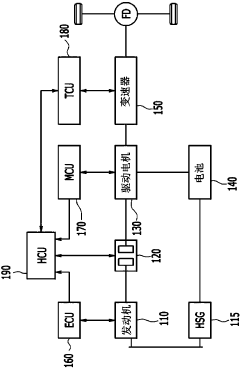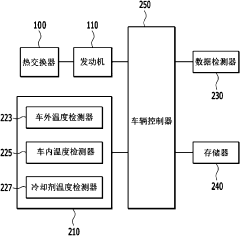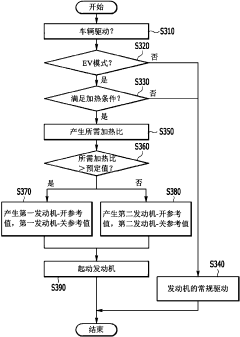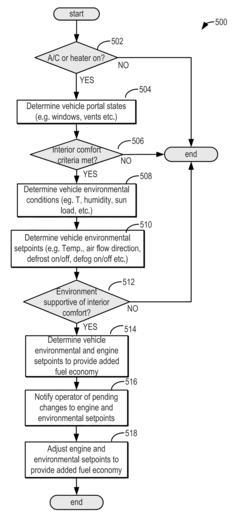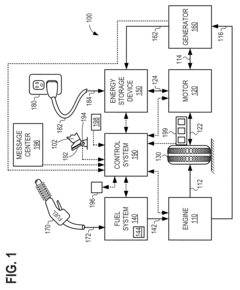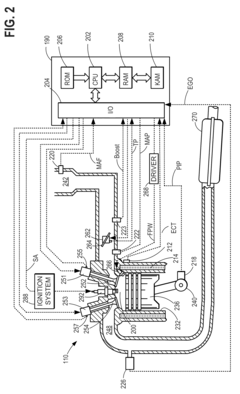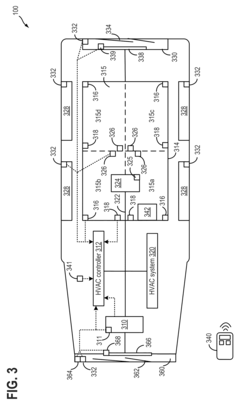PHEV's effect on vehicular thermal comfort
AUG 14, 20259 MIN READ
Generate Your Research Report Instantly with AI Agent
Patsnap Eureka helps you evaluate technical feasibility & market potential.
PHEV Thermal Comfort Background and Objectives
Plug-in Hybrid Electric Vehicles (PHEVs) have emerged as a significant technological advancement in the automotive industry, bridging the gap between conventional internal combustion engine vehicles and fully electric vehicles. The evolution of PHEV technology has been driven by the global push for reduced emissions, improved fuel efficiency, and enhanced vehicle performance. As these vehicles combine both electric and gasoline powertrains, they present unique challenges and opportunities in terms of thermal comfort management.
The primary objective of this technical research report is to comprehensively examine the effects of PHEV technology on vehicular thermal comfort. This involves exploring the intricate relationship between the hybrid powertrain system and the vehicle's climate control mechanisms. The goal is to understand how the dual-power nature of PHEVs impacts the heating, ventilation, and air conditioning (HVAC) systems, and consequently, the overall thermal comfort experienced by passengers.
A key focus of this investigation is to analyze the thermal management strategies employed in PHEVs, which differ significantly from those in conventional vehicles. The presence of both an internal combustion engine and an electric motor introduces new variables in heat generation and dissipation. This dual-source heat management presents both challenges and opportunities for optimizing cabin temperature control and energy efficiency.
Furthermore, this research aims to evaluate the impact of PHEV operation modes on thermal comfort. The transition between electric-only, hybrid, and gasoline-only modes can affect the availability and distribution of heat within the vehicle. Understanding these dynamics is crucial for developing effective thermal comfort solutions that can adapt to the varying operational states of PHEVs.
Another critical aspect of this study is to assess the energy trade-offs involved in maintaining optimal thermal comfort in PHEVs. The use of battery power for propulsion competes with its use for climate control, particularly in electric-only mode. This research seeks to explore innovative approaches to balance these competing demands, potentially leading to more efficient and effective thermal management systems.
The technological trajectory of PHEVs suggests a trend towards increased electrification and more sophisticated power management systems. This evolution is expected to have profound implications for thermal comfort technologies. As such, this research also aims to anticipate future developments in PHEV thermal management, considering emerging technologies such as advanced heat pumps, phase-change materials, and intelligent climate control systems.
By thoroughly examining these aspects, this technical research report aims to provide valuable insights into the current state and future directions of thermal comfort in PHEVs. The findings are expected to contribute significantly to the development of next-generation PHEVs, enhancing both energy efficiency and passenger comfort.
The primary objective of this technical research report is to comprehensively examine the effects of PHEV technology on vehicular thermal comfort. This involves exploring the intricate relationship between the hybrid powertrain system and the vehicle's climate control mechanisms. The goal is to understand how the dual-power nature of PHEVs impacts the heating, ventilation, and air conditioning (HVAC) systems, and consequently, the overall thermal comfort experienced by passengers.
A key focus of this investigation is to analyze the thermal management strategies employed in PHEVs, which differ significantly from those in conventional vehicles. The presence of both an internal combustion engine and an electric motor introduces new variables in heat generation and dissipation. This dual-source heat management presents both challenges and opportunities for optimizing cabin temperature control and energy efficiency.
Furthermore, this research aims to evaluate the impact of PHEV operation modes on thermal comfort. The transition between electric-only, hybrid, and gasoline-only modes can affect the availability and distribution of heat within the vehicle. Understanding these dynamics is crucial for developing effective thermal comfort solutions that can adapt to the varying operational states of PHEVs.
Another critical aspect of this study is to assess the energy trade-offs involved in maintaining optimal thermal comfort in PHEVs. The use of battery power for propulsion competes with its use for climate control, particularly in electric-only mode. This research seeks to explore innovative approaches to balance these competing demands, potentially leading to more efficient and effective thermal management systems.
The technological trajectory of PHEVs suggests a trend towards increased electrification and more sophisticated power management systems. This evolution is expected to have profound implications for thermal comfort technologies. As such, this research also aims to anticipate future developments in PHEV thermal management, considering emerging technologies such as advanced heat pumps, phase-change materials, and intelligent climate control systems.
By thoroughly examining these aspects, this technical research report aims to provide valuable insights into the current state and future directions of thermal comfort in PHEVs. The findings are expected to contribute significantly to the development of next-generation PHEVs, enhancing both energy efficiency and passenger comfort.
Market Analysis for PHEV Thermal Comfort Solutions
The market for PHEV thermal comfort solutions is experiencing significant growth, driven by the increasing adoption of plug-in hybrid electric vehicles (PHEVs) and the growing demand for enhanced passenger comfort. As PHEVs combine both internal combustion engines and electric powertrains, they present unique challenges and opportunities for thermal management systems.
The global PHEV market is projected to expand rapidly in the coming years, with a corresponding increase in demand for advanced thermal comfort solutions. This growth is fueled by stringent emissions regulations, government incentives for eco-friendly vehicles, and consumer interest in fuel-efficient transportation options. As a result, the market for PHEV thermal comfort systems is expected to see substantial expansion.
One of the key drivers for this market is the need to optimize energy consumption in PHEVs. Efficient thermal management systems can significantly impact the vehicle's overall energy efficiency and electric range. Consumers are increasingly aware of the importance of thermal comfort in their driving experience, and are willing to invest in vehicles that offer superior climate control without compromising on fuel economy or electric range.
The market for PHEV thermal comfort solutions encompasses a wide range of components and systems, including advanced HVAC systems, heat pumps, thermal storage materials, and intelligent control algorithms. These technologies are designed to address the specific challenges of PHEVs, such as managing heat during electric-only operation and optimizing the transition between electric and combustion engine modes.
Regional markets show varying levels of maturity and growth potential. Europe and North America are currently leading in PHEV adoption and, consequently, in the demand for advanced thermal comfort solutions. However, rapidly growing markets in Asia, particularly China, are expected to become significant drivers of demand in the near future.
The competitive landscape of the PHEV thermal comfort market is characterized by a mix of established automotive suppliers and innovative startups. Major players are investing heavily in research and development to create more efficient and cost-effective solutions. Collaborations between automakers and technology providers are becoming increasingly common, as companies seek to leverage expertise across different domains.
Consumer preferences are shaping the market, with a growing emphasis on personalized comfort settings, rapid cabin heating and cooling, and seamless integration with vehicle infotainment systems. There is also an increasing focus on sustainable materials and environmentally friendly refrigerants in thermal management systems.
Looking ahead, the market for PHEV thermal comfort solutions is poised for continued growth and innovation. Emerging technologies such as artificial intelligence and advanced sensors are expected to play a crucial role in developing next-generation thermal management systems that can anticipate and adapt to user preferences while maximizing energy efficiency.
The global PHEV market is projected to expand rapidly in the coming years, with a corresponding increase in demand for advanced thermal comfort solutions. This growth is fueled by stringent emissions regulations, government incentives for eco-friendly vehicles, and consumer interest in fuel-efficient transportation options. As a result, the market for PHEV thermal comfort systems is expected to see substantial expansion.
One of the key drivers for this market is the need to optimize energy consumption in PHEVs. Efficient thermal management systems can significantly impact the vehicle's overall energy efficiency and electric range. Consumers are increasingly aware of the importance of thermal comfort in their driving experience, and are willing to invest in vehicles that offer superior climate control without compromising on fuel economy or electric range.
The market for PHEV thermal comfort solutions encompasses a wide range of components and systems, including advanced HVAC systems, heat pumps, thermal storage materials, and intelligent control algorithms. These technologies are designed to address the specific challenges of PHEVs, such as managing heat during electric-only operation and optimizing the transition between electric and combustion engine modes.
Regional markets show varying levels of maturity and growth potential. Europe and North America are currently leading in PHEV adoption and, consequently, in the demand for advanced thermal comfort solutions. However, rapidly growing markets in Asia, particularly China, are expected to become significant drivers of demand in the near future.
The competitive landscape of the PHEV thermal comfort market is characterized by a mix of established automotive suppliers and innovative startups. Major players are investing heavily in research and development to create more efficient and cost-effective solutions. Collaborations between automakers and technology providers are becoming increasingly common, as companies seek to leverage expertise across different domains.
Consumer preferences are shaping the market, with a growing emphasis on personalized comfort settings, rapid cabin heating and cooling, and seamless integration with vehicle infotainment systems. There is also an increasing focus on sustainable materials and environmentally friendly refrigerants in thermal management systems.
Looking ahead, the market for PHEV thermal comfort solutions is poised for continued growth and innovation. Emerging technologies such as artificial intelligence and advanced sensors are expected to play a crucial role in developing next-generation thermal management systems that can anticipate and adapt to user preferences while maximizing energy efficiency.
PHEV Thermal Management Challenges
Plug-in Hybrid Electric Vehicles (PHEVs) present unique challenges in thermal management due to their dual powertrain architecture. The integration of both internal combustion engines and electric motors creates a complex thermal environment that requires innovative solutions to maintain optimal performance and efficiency.
One of the primary challenges in PHEV thermal management is the need to balance the thermal requirements of multiple systems. The internal combustion engine, electric motor, battery pack, and power electronics all have different optimal operating temperatures and cooling needs. This complexity necessitates a sophisticated thermal management system that can effectively distribute cooling resources and manage heat flow throughout the vehicle.
Battery thermal management is particularly critical in PHEVs. The lithium-ion batteries used in these vehicles are sensitive to temperature fluctuations, with performance and lifespan significantly impacted by both high and low temperatures. Maintaining the battery pack within its optimal temperature range (typically between 20°C and 40°C) is essential for maximizing electric range, prolonging battery life, and ensuring safety. This challenge is compounded by the fact that PHEVs may operate in all-electric mode for extended periods, requiring efficient battery cooling even when the internal combustion engine is not running.
The transition between electric and hybrid modes presents another thermal management challenge. When the internal combustion engine starts after a period of all-electric operation, it must quickly reach its optimal operating temperature to minimize emissions and maximize efficiency. This rapid heating requirement can place additional strain on the vehicle's thermal management system, particularly in cold weather conditions.
Cabin climate control in PHEVs also poses unique challenges. In conventional vehicles, waste heat from the engine is used for cabin heating. However, in electric mode, PHEVs lack this heat source, necessitating alternative heating solutions that don't significantly impact the electric range. This often involves the use of electric heaters or heat pumps, which must be carefully integrated into the overall thermal management strategy.
The need for efficient thermal management in PHEVs extends to the power electronics and electric motor as well. These components generate significant heat during operation and require effective cooling to maintain performance and longevity. The thermal management system must be capable of handling the varying heat loads produced by these components across different driving conditions and operating modes.
Furthermore, the compact design of many PHEVs creates packaging challenges for thermal management components. Engineers must develop innovative solutions to integrate cooling systems, heat exchangers, and thermal management controls within limited space constraints, while also considering weight implications to maintain vehicle efficiency.
One of the primary challenges in PHEV thermal management is the need to balance the thermal requirements of multiple systems. The internal combustion engine, electric motor, battery pack, and power electronics all have different optimal operating temperatures and cooling needs. This complexity necessitates a sophisticated thermal management system that can effectively distribute cooling resources and manage heat flow throughout the vehicle.
Battery thermal management is particularly critical in PHEVs. The lithium-ion batteries used in these vehicles are sensitive to temperature fluctuations, with performance and lifespan significantly impacted by both high and low temperatures. Maintaining the battery pack within its optimal temperature range (typically between 20°C and 40°C) is essential for maximizing electric range, prolonging battery life, and ensuring safety. This challenge is compounded by the fact that PHEVs may operate in all-electric mode for extended periods, requiring efficient battery cooling even when the internal combustion engine is not running.
The transition between electric and hybrid modes presents another thermal management challenge. When the internal combustion engine starts after a period of all-electric operation, it must quickly reach its optimal operating temperature to minimize emissions and maximize efficiency. This rapid heating requirement can place additional strain on the vehicle's thermal management system, particularly in cold weather conditions.
Cabin climate control in PHEVs also poses unique challenges. In conventional vehicles, waste heat from the engine is used for cabin heating. However, in electric mode, PHEVs lack this heat source, necessitating alternative heating solutions that don't significantly impact the electric range. This often involves the use of electric heaters or heat pumps, which must be carefully integrated into the overall thermal management strategy.
The need for efficient thermal management in PHEVs extends to the power electronics and electric motor as well. These components generate significant heat during operation and require effective cooling to maintain performance and longevity. The thermal management system must be capable of handling the varying heat loads produced by these components across different driving conditions and operating modes.
Furthermore, the compact design of many PHEVs creates packaging challenges for thermal management components. Engineers must develop innovative solutions to integrate cooling systems, heat exchangers, and thermal management controls within limited space constraints, while also considering weight implications to maintain vehicle efficiency.
Current PHEV Thermal Comfort Strategies
01 Thermal management systems for PHEVs
Advanced thermal management systems are developed for PHEVs to optimize the temperature of various components, including the battery, electric motor, and cabin. These systems often integrate heat pumps, coolant circuits, and intelligent control algorithms to efficiently manage heat distribution and improve overall vehicle efficiency and comfort.- Thermal management systems for PHEVs: Advanced thermal management systems are developed for PHEVs to optimize the temperature of various components, including the battery, electric motor, and cabin. These systems often integrate heat pumps, coolant circuits, and intelligent control algorithms to efficiently manage heat distribution and improve overall vehicle efficiency and comfort.
- Cabin pre-conditioning for PHEVs: Pre-conditioning systems are implemented in PHEVs to adjust the cabin temperature before the driver enters the vehicle. This feature utilizes the vehicle's battery power while plugged in, reducing the energy consumption during initial driving and enhancing passenger comfort without compromising electric range.
- Integration of renewable energy for PHEV climate control: Innovative solutions incorporate renewable energy sources, such as solar panels, to supplement the vehicle's power supply for climate control. This approach helps reduce the load on the main battery, extending the electric driving range while maintaining optimal thermal comfort in the cabin.
- Adaptive thermal comfort strategies for PHEVs: Intelligent systems are developed to adapt thermal comfort settings based on various factors such as occupancy, driving mode, and external conditions. These strategies optimize energy usage while maintaining passenger comfort by adjusting heating, ventilation, and air conditioning (HVAC) settings dynamically.
- Waste heat recovery for PHEV thermal management: Advanced waste heat recovery systems are designed to capture and repurpose heat generated by the internal combustion engine, electric motors, and other components. This recovered heat is then used for cabin heating or battery temperature regulation, improving overall energy efficiency and thermal comfort in PHEVs.
02 Cabin pre-conditioning for PHEVs
Pre-conditioning systems are implemented in PHEVs to adjust the cabin temperature before the driver enters the vehicle. This feature utilizes the vehicle's battery power or grid electricity while the vehicle is still plugged in, reducing the energy consumption during the initial drive and enhancing passenger comfort.Expand Specific Solutions03 Energy-efficient HVAC systems for PHEVs
Specialized HVAC systems are designed for PHEVs to provide optimal thermal comfort while minimizing energy consumption. These systems may incorporate advanced sensors, zonal heating/cooling, and adaptive control strategies to balance comfort and efficiency based on driving conditions and passenger preferences.Expand Specific Solutions04 Integration of renewable energy for PHEV climate control
Innovative approaches are explored to integrate renewable energy sources, such as solar panels, with PHEV climate control systems. These solutions aim to supplement the vehicle's power supply for heating and cooling, reducing the load on the main battery and extending the electric driving range while maintaining thermal comfort.Expand Specific Solutions05 Adaptive thermal comfort strategies for PHEVs
Intelligent control systems are developed to implement adaptive thermal comfort strategies in PHEVs. These systems consider factors such as occupancy, individual preferences, driving mode, and environmental conditions to dynamically adjust the climate control settings, optimizing both energy efficiency and passenger comfort.Expand Specific Solutions
Key PHEV Thermal Comfort Solution Providers
The competitive landscape for PHEV's effect on vehicular thermal comfort is evolving rapidly, with the market in a growth phase. As automotive electrification accelerates, the global PHEV market is expanding, driven by environmental regulations and consumer demand for fuel-efficient vehicles. Major players like Toyota, Ford, BMW, and Hyundai are investing heavily in PHEV technology, focusing on improving thermal management systems. Companies such as Johnson Controls and Hanon Systems are developing advanced climate control solutions specifically for PHEVs. The technology is maturing, with ongoing research at institutions like Chongqing University and Hefei University of Technology contributing to innovations in thermal comfort for hybrid vehicles.
Ford Global Technologies LLC
Technical Solution: Ford has developed a sophisticated thermal management system for PHEVs that focuses on optimizing the balance between electric range and cabin comfort. Their system utilizes a variable-speed electric compressor for the air conditioning system, which can operate efficiently in both electric and hybrid modes. Ford has also implemented a heat pump system that can extract heat from the ambient air and the vehicle's powertrain components to warm the cabin efficiently[4]. The company has developed an intelligent control strategy that predicts heating and cooling needs based on factors such as weather conditions, solar load, and occupant preferences, allowing for proactive thermal management[5].
Strengths: Adaptive system that balances performance and comfort. Weaknesses: May require frequent software updates to maintain optimal performance.
Toyota Motor Corp.
Technical Solution: Toyota has developed an advanced thermal management system for PHEVs that integrates the engine cooling system with the electric powertrain cooling system. This system utilizes a heat pump for cabin heating and cooling, which can extract heat from the ambient air or the powertrain components. The system also incorporates a thermal storage unit that can store waste heat from the engine and electric motors for later use in cabin heating[1][3]. Additionally, Toyota has implemented predictive energy management algorithms that optimize the use of battery power and engine operation based on route information and driving conditions, further enhancing thermal comfort and energy efficiency[2].
Strengths: Highly integrated system that maximizes energy efficiency and thermal comfort. Weaknesses: Complexity may lead to higher costs and potential reliability issues in the long term.
Innovative PHEV Thermal Management Technologies
Heating control apparatus and method for plug-in hybrid electric vehicle
PatentActiveCN107662471A
Innovation
- Through the temperature detection device and the vehicle controller, the engine opening and closing reference values are generated according to the required heating ratio, optimizing the engine operation to quickly reach the target coolant temperature, thereby improving the heating efficiency in the vehicle.
Utilization of vehicle portal states to assess interior comfort and adjust vehicle operation to provide additional fuel economy
PatentActiveUS8849487B2
Innovation
- A method that adjusts the climate control system's operation based on vehicle window and vent states, reducing compressor or blower speed when windows or vents are open to conserve energy without degrading comfort, allowing ambient air to cool the interior and optimizing engine operation for better fuel economy.
Energy Efficiency Impact on PHEV Thermal Comfort
The energy efficiency of Plug-in Hybrid Electric Vehicles (PHEVs) plays a crucial role in determining the overall thermal comfort experience for passengers. As PHEVs rely on both electric and combustion power sources, their energy management strategies directly influence the available power for climate control systems.
In electric-only mode, PHEVs face challenges in maintaining optimal thermal comfort due to limited battery capacity. The power required for heating, ventilation, and air conditioning (HVAC) systems can significantly reduce the electric driving range. This necessitates careful balancing between energy allocation for propulsion and climate control to maximize efficiency without compromising passenger comfort.
Advanced thermal management technologies, such as heat pumps and waste heat recovery systems, have been developed to address these challenges. Heat pumps, in particular, offer higher efficiency compared to traditional resistive heating methods, allowing PHEVs to maintain comfortable cabin temperatures with reduced energy consumption. This technology becomes especially beneficial in colder climates where heating demands are high.
The integration of smart climate control systems in PHEVs further enhances energy efficiency. These systems utilize predictive algorithms and real-time data to optimize HVAC operation based on factors such as occupancy, weather conditions, and driving patterns. By minimizing unnecessary climate control usage, these intelligent systems contribute to extended electric range while maintaining passenger comfort.
Energy recuperation during braking and deceleration also impacts thermal comfort in PHEVs. The recovered energy can be utilized to power auxiliary systems, including climate control, thereby reducing the overall energy demand on the battery. This synergy between regenerative braking and thermal management systems contributes to improved energy efficiency and extended electric driving range.
The transition between electric and combustion modes in PHEVs presents unique challenges and opportunities for thermal comfort management. Intelligent powertrain control strategies can be employed to optimize the use of waste heat from the internal combustion engine for cabin heating, reducing the reliance on battery power for climate control during hybrid operation.
As PHEV technology continues to evolve, the focus on energy-efficient thermal comfort solutions is likely to intensify. Future developments may include advanced insulation materials, zonal climate control, and integration with vehicle-to-grid (V2G) systems to further optimize energy usage and enhance the overall driving experience.
In electric-only mode, PHEVs face challenges in maintaining optimal thermal comfort due to limited battery capacity. The power required for heating, ventilation, and air conditioning (HVAC) systems can significantly reduce the electric driving range. This necessitates careful balancing between energy allocation for propulsion and climate control to maximize efficiency without compromising passenger comfort.
Advanced thermal management technologies, such as heat pumps and waste heat recovery systems, have been developed to address these challenges. Heat pumps, in particular, offer higher efficiency compared to traditional resistive heating methods, allowing PHEVs to maintain comfortable cabin temperatures with reduced energy consumption. This technology becomes especially beneficial in colder climates where heating demands are high.
The integration of smart climate control systems in PHEVs further enhances energy efficiency. These systems utilize predictive algorithms and real-time data to optimize HVAC operation based on factors such as occupancy, weather conditions, and driving patterns. By minimizing unnecessary climate control usage, these intelligent systems contribute to extended electric range while maintaining passenger comfort.
Energy recuperation during braking and deceleration also impacts thermal comfort in PHEVs. The recovered energy can be utilized to power auxiliary systems, including climate control, thereby reducing the overall energy demand on the battery. This synergy between regenerative braking and thermal management systems contributes to improved energy efficiency and extended electric driving range.
The transition between electric and combustion modes in PHEVs presents unique challenges and opportunities for thermal comfort management. Intelligent powertrain control strategies can be employed to optimize the use of waste heat from the internal combustion engine for cabin heating, reducing the reliance on battery power for climate control during hybrid operation.
As PHEV technology continues to evolve, the focus on energy-efficient thermal comfort solutions is likely to intensify. Future developments may include advanced insulation materials, zonal climate control, and integration with vehicle-to-grid (V2G) systems to further optimize energy usage and enhance the overall driving experience.
User Experience and Comfort Metrics for PHEVs
User experience and comfort metrics for PHEVs are crucial aspects in evaluating the overall performance and consumer acceptance of these vehicles. As PHEVs combine both electric and conventional powertrains, they present unique challenges and opportunities in terms of thermal comfort and user satisfaction.
One of the primary metrics for assessing user experience in PHEVs is the consistency and efficiency of the climate control system. Unlike conventional vehicles, PHEVs must manage thermal comfort across different driving modes, transitioning seamlessly between electric and hybrid operations. This requires sophisticated control algorithms that can maintain a stable cabin temperature while optimizing energy consumption.
Thermal management in PHEVs also extends to battery temperature control, which directly impacts vehicle performance and user comfort. Effective battery thermal management systems contribute to improved range, faster charging times, and longer battery life, all of which enhance the overall user experience.
Noise, vibration, and harshness (NVH) levels are another critical set of metrics for PHEVs. The transition between electric and combustion engine modes should be imperceptible to occupants, ensuring a smooth and comfortable ride. Advanced sound insulation techniques and active noise cancellation systems are often employed to maintain a quiet cabin environment, particularly during electric-only operation.
Cabin pre-conditioning is a feature unique to electrified vehicles that significantly impacts user comfort. The ability to remotely heat or cool the vehicle interior while it's still plugged in not only enhances comfort but also preserves battery charge for driving range. User satisfaction metrics often include the effectiveness and ease of use of these pre-conditioning systems.
Energy efficiency indicators that relate to comfort features are also important metrics. These may include the impact of climate control usage on electric range, the effectiveness of heat pump systems in cold weather, and the overall energy management of auxiliary systems. Users often evaluate their PHEV experience based on how well the vehicle balances comfort with efficiency.
Ergonomics and user interface design play a crucial role in the comfort metrics of PHEVs. Intuitive controls for managing driving modes, regenerative braking, and climate settings contribute to a more comfortable and less stressful driving experience. The clarity and usefulness of information displayed about energy usage, charging status, and range estimations are also key factors in user satisfaction.
Lastly, adaptive comfort systems that learn user preferences and adjust accordingly are becoming increasingly important in PHEVs. These systems can optimize thermal comfort based on individual preferences, time of day, and even predicted route conditions, further enhancing the user experience and differentiating PHEVs in the competitive automotive market.
One of the primary metrics for assessing user experience in PHEVs is the consistency and efficiency of the climate control system. Unlike conventional vehicles, PHEVs must manage thermal comfort across different driving modes, transitioning seamlessly between electric and hybrid operations. This requires sophisticated control algorithms that can maintain a stable cabin temperature while optimizing energy consumption.
Thermal management in PHEVs also extends to battery temperature control, which directly impacts vehicle performance and user comfort. Effective battery thermal management systems contribute to improved range, faster charging times, and longer battery life, all of which enhance the overall user experience.
Noise, vibration, and harshness (NVH) levels are another critical set of metrics for PHEVs. The transition between electric and combustion engine modes should be imperceptible to occupants, ensuring a smooth and comfortable ride. Advanced sound insulation techniques and active noise cancellation systems are often employed to maintain a quiet cabin environment, particularly during electric-only operation.
Cabin pre-conditioning is a feature unique to electrified vehicles that significantly impacts user comfort. The ability to remotely heat or cool the vehicle interior while it's still plugged in not only enhances comfort but also preserves battery charge for driving range. User satisfaction metrics often include the effectiveness and ease of use of these pre-conditioning systems.
Energy efficiency indicators that relate to comfort features are also important metrics. These may include the impact of climate control usage on electric range, the effectiveness of heat pump systems in cold weather, and the overall energy management of auxiliary systems. Users often evaluate their PHEV experience based on how well the vehicle balances comfort with efficiency.
Ergonomics and user interface design play a crucial role in the comfort metrics of PHEVs. Intuitive controls for managing driving modes, regenerative braking, and climate settings contribute to a more comfortable and less stressful driving experience. The clarity and usefulness of information displayed about energy usage, charging status, and range estimations are also key factors in user satisfaction.
Lastly, adaptive comfort systems that learn user preferences and adjust accordingly are becoming increasingly important in PHEVs. These systems can optimize thermal comfort based on individual preferences, time of day, and even predicted route conditions, further enhancing the user experience and differentiating PHEVs in the competitive automotive market.
Unlock deeper insights with Patsnap Eureka Quick Research — get a full tech report to explore trends and direct your research. Try now!
Generate Your Research Report Instantly with AI Agent
Supercharge your innovation with Patsnap Eureka AI Agent Platform!
